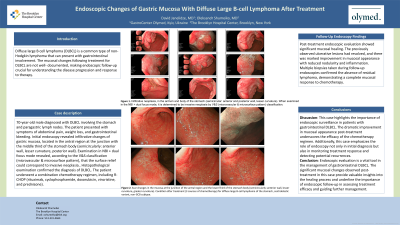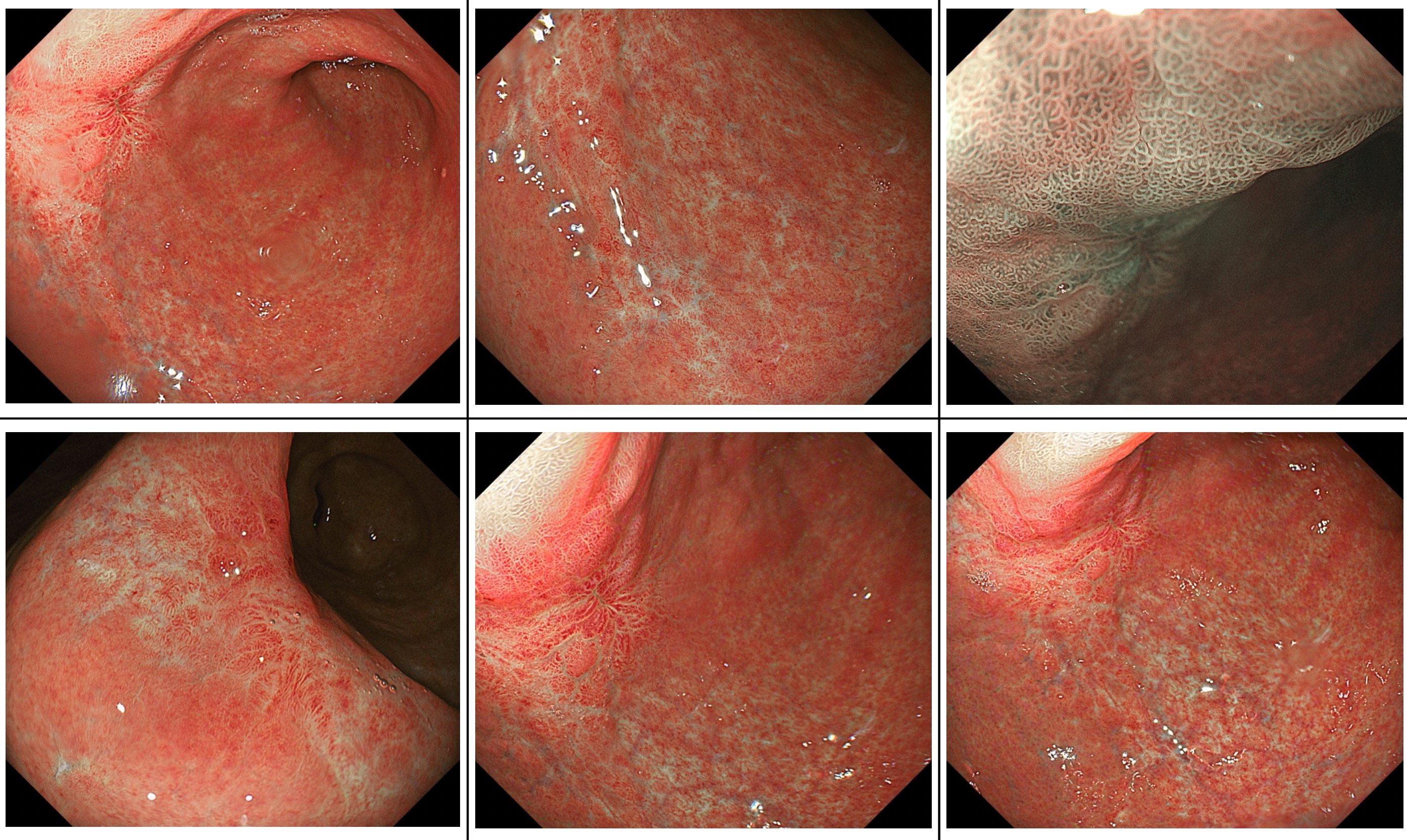Sunday Poster Session
Category: Stomach
P1710 - Endoscopic Changes of Gastric Mucosa With Diffuse Large B-Cell Lymphoma After Treatment
Sunday, October 27, 2024
3:30 PM - 7:00 PM ET
Location: Exhibit Hall E

Has Audio

Oleksandr Shumeiko, MD
Brooklyn Hospital Center
Brooklyn, NY
Presenting Author(s)
David Janelidze, MD, PhD1, Oleksandr Shumeiko, MD2
1GastroCenter Olymed, Kyiv, Kyyiv, Ukraine; 2Brooklyn Hospital Center, Brooklyn, NY
Introduction: Diffuse large B cell lymphoma (DLBCL) is a common type of non-Hodgkin lymphoma that can present with gastrointestinal involvement. The mucosal changes following treatment for DLBCL are not well-documented, making endoscopic follow-up crucial for understanding the disease progression and response to therapy.
Case Description/Methods: Case Presentation: We report a case of a 70-year-old male diagnosed with DLBCL involving the stomach and paragastric lymph nodes. The patient presented with symptoms of abdominal pain, weight loss, and gastrointestinal bleeding. Initial endoscopy revealed infiltrative changes of gastric mucosa, located in the antral region at the junction with the middle third of the stomach body (semicircularly: anterior wall, lesser curvature, posterior wall). Examination in NBI + dual focus mode revealed, according to the V&S classification (microvascular & microsurface pattern), that the surface relief could correspond to invasive neoplasia.. Histopathological examination confirmed the diagnosis of DLBCL. The patient underwent a combination chemotherapy regimen, including R-CHOP (rituximab, cyclophosphamide, doxorubicin, vincristine, and prednisone).
Follow-Up Endoscopy Findings: Post-treatment endoscopic evaluation showed significant mucosal healing. The previously observed ulcerative lesions had resolved, and there was marked improvement in mucosal appearance with reduced nodularity and inflammation. Multiple biopsies taken during follow-up endoscopies confirmed the absence of residual lymphoma, demonstrating a complete mucosal response to chemotherapy.
Discussion: Discussion: This case highlights the importance of endoscopic surveillance in patients with gastrointestinal DLBCL. The dramatic improvement in mucosal appearance post-treatment underscores the efficacy of the chemotherapy regimen. Additionally, this case emphasizes the role of endoscopy not only in initial diagnosis but also in monitoring treatment response and detecting potential recurrences.
Conclusion: Endoscopic evaluation is a vital tool in the management of gastrointestinal DLBCL. The significant mucosal changes observed post-treatment in this case provide valuable insights into the healing process and underline the importance of endoscopic follow-up in assessing treatment efficacy and guiding further management.

Disclosures:
David Janelidze, MD, PhD1, Oleksandr Shumeiko, MD2. P1710 - Endoscopic Changes of Gastric Mucosa With Diffuse Large B-Cell Lymphoma After Treatment, ACG 2024 Annual Scientific Meeting Abstracts. Philadelphia, PA: American College of Gastroenterology.
1GastroCenter Olymed, Kyiv, Kyyiv, Ukraine; 2Brooklyn Hospital Center, Brooklyn, NY
Introduction: Diffuse large B cell lymphoma (DLBCL) is a common type of non-Hodgkin lymphoma that can present with gastrointestinal involvement. The mucosal changes following treatment for DLBCL are not well-documented, making endoscopic follow-up crucial for understanding the disease progression and response to therapy.
Case Description/Methods: Case Presentation: We report a case of a 70-year-old male diagnosed with DLBCL involving the stomach and paragastric lymph nodes. The patient presented with symptoms of abdominal pain, weight loss, and gastrointestinal bleeding. Initial endoscopy revealed infiltrative changes of gastric mucosa, located in the antral region at the junction with the middle third of the stomach body (semicircularly: anterior wall, lesser curvature, posterior wall). Examination in NBI + dual focus mode revealed, according to the V&S classification (microvascular & microsurface pattern), that the surface relief could correspond to invasive neoplasia.. Histopathological examination confirmed the diagnosis of DLBCL. The patient underwent a combination chemotherapy regimen, including R-CHOP (rituximab, cyclophosphamide, doxorubicin, vincristine, and prednisone).
Follow-Up Endoscopy Findings: Post-treatment endoscopic evaluation showed significant mucosal healing. The previously observed ulcerative lesions had resolved, and there was marked improvement in mucosal appearance with reduced nodularity and inflammation. Multiple biopsies taken during follow-up endoscopies confirmed the absence of residual lymphoma, demonstrating a complete mucosal response to chemotherapy.
Discussion: Discussion: This case highlights the importance of endoscopic surveillance in patients with gastrointestinal DLBCL. The dramatic improvement in mucosal appearance post-treatment underscores the efficacy of the chemotherapy regimen. Additionally, this case emphasizes the role of endoscopy not only in initial diagnosis but also in monitoring treatment response and detecting potential recurrences.
Conclusion: Endoscopic evaluation is a vital tool in the management of gastrointestinal DLBCL. The significant mucosal changes observed post-treatment in this case provide valuable insights into the healing process and underline the importance of endoscopic follow-up in assessing treatment efficacy and guiding further management.

Figure: Scar changes in the mucosa at the junction of the antral region and the lower third of the stomach body (semicircularly: anterior wall, lesser curvature, greater curvature). Condition after treatment (3 courses of chemotherapy) for diffuse large B-cell lymphoma of the stomach, centroblastic variant, non-GCB subtype.
Disclosures:
David Janelidze indicated no relevant financial relationships.
Oleksandr Shumeiko indicated no relevant financial relationships.
David Janelidze, MD, PhD1, Oleksandr Shumeiko, MD2. P1710 - Endoscopic Changes of Gastric Mucosa With Diffuse Large B-Cell Lymphoma After Treatment, ACG 2024 Annual Scientific Meeting Abstracts. Philadelphia, PA: American College of Gastroenterology.
